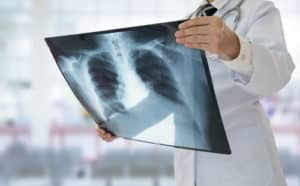Chicago Tuberculosis (TB) Outbreak Lawyers

While tuberculosis (TB) is nowhere near as common as it once was in our country, the risk of a TB outbreak remains a serious concern. This is especially true in hospitals and other healthcare facilities where the disease can be readily spread among patients and workers in tight, enclosed areas such as patient rooms or treatment rooms. Because the disease can be deadly, it is important to get treatment right away.
Salvi, Schostok & Pritchard P.C., has recently received a number of calls from Chicago area individuals who have been diagnosed with TB. They believe they were exposed while in the care of a local medical facility.
If you or a loved one has been diagnosed with TB during or soon after a hospital or healthcare facility stay, it’s possible it was the cause of medical negligence. We can help.
To get you started, we’ve included some general information on TB below.
What is Tuberculosis?
Tuberculosis is an infectious disease. It is caused by bacteria called Mycobacterium tuberculosis. According to the U.S. Centers for Disease Control and Prevention (CDC), the disease is spread through the air by inhaling the TB bacteria. When a person with active TB disease coughs, sneezes, spits or simply speaks, others may breathe the TB bacteria and become infected. At first, the bacteria reach and infect the lungs. The disease can then spread through the body to areas such as the kidney, spine and brain.
There are three ways TB outbreaks can occur in hospitals:
- Tight spaces – Hospital rooms tend to be small, enclosed spaces. If TB bacteria are emitted, it may linger in these tight spaces for an extended period and inhaled by others.
- Poor ventilation – An inadequate ventilation system in a hospital may prevent the TB bacteria from being diluted or removed from the air or cause air containing the bacteria to be re-circulated through the ventilation system.
- Lack of protective gear – Unfortunately, hospitals may not have procedures in place that can help to prevent the spread of an infectious disease such as tuberculosis. For instance, there may be no requirement for certain high-risk patients and workers to wear facemasks. Or, in some cases, procedures may be in place that are not followed.
The chief concern with tuberculosis is that it only takes a small concentration of the bacteria to infect a person. That’s why it can trigger an outbreak if not addressed quickly and effectively.
What are Symptoms of Tuberculosis?
The CDC says people with weak immune systems are highly susceptible to active TB disease. These individuals include babies and small children as well as individuals suffering from:
- HIV infection
- Diabetes
- Silicosis
- Head or neck cancer
- Leukemia or Hodgkin’s disease
- Severe kidney disease
- Drug or alcohol addiction / abuse
- Low body weight
- Organ transplant patients
- Those undergoing specialized treatment for rheumatoid arthritis or Crohn’s disease.
According to the American Lung Association (ALA), a person with active TB disease may display the following symptoms:
- Persistent cough
- Constant fatigue
- Weight loss
- Loss of appetite
- Fever
- Coughing up blood
- Night sweats.
Because these symptoms can arise with other types of disease, the ALA says it is crucial to undergo testing for TB if one has reason to believe that they have contracted the disease. The two most common tests are:
- TB Skin Test – This test involves the injection of a material called tuberculin under the skin in your arm. Within 2-3 days after the injection, the physician will determine whether there was a reaction to the injection, such as swelling that indicates a positive test for tuberculosis. Even if an initial test comes back negative, the CDC suggests undergoing a second test for assurance that there has been no infection.
- TB Blood Test – Different types of blood tests can be administered that measure the response of TB proteins when they are mixed with small blood samples.
Chest X-rays and samples of sputum (phlegm from deep inside the lungs) may also be used to test for tuberculosis.
Treatment of Tuberculosis
If you have only a TB infection but not active TB disease, then you may undergo preventative therapy that involves taking daily amounts of a drug called isoniazid (INH) for a period of 6 to 9 months, the CDC says.
If you have active TB disease, you may require hospitalization for a brief period and placed on an extended medication schedule that may last from 6 to 12 months after you return home. The medication may include taking isoniazid (INH) along with other drugs such as rifampin, pyrazinamide and ethambutol. These drugs will help to fight the TB bacteria in your body.
In some cases, people may suffer from side effects and complications after consuming these drugs. Also, because TB is contagious, a person with active TB disease may need to stay isolated for a long period while undergoing treatment. It may take weeks or months before the person is able to return to school or work. This can lead to a serious disruption in one’s life, harm a person’s income and lead to other problems such as stress, anxiety and depression.
Have You Been Infected with Tuberculosis? Get Legal Help Today
If you or a loved one has contracted tuberculosis while being treated at a hospital, you should contact a Chicago hospital infection lawyer immediately to learn about your legal rights and options. An attorney can help you to secure funds that can pay for your medical treatment and compensate you for other financial, physical and emotional harm you have suffered.
To schedule a free and confidential consultation, call Salvi, Schostok & Pritchard P.C., today at our toll-free number or use our quick contact form. We serve medical negligence victims throughout Chicago, Waukegan, Cook County, Lake County and across Illinois. We can review your case, discuss your options and get to work on securing the compensation you deserve.









